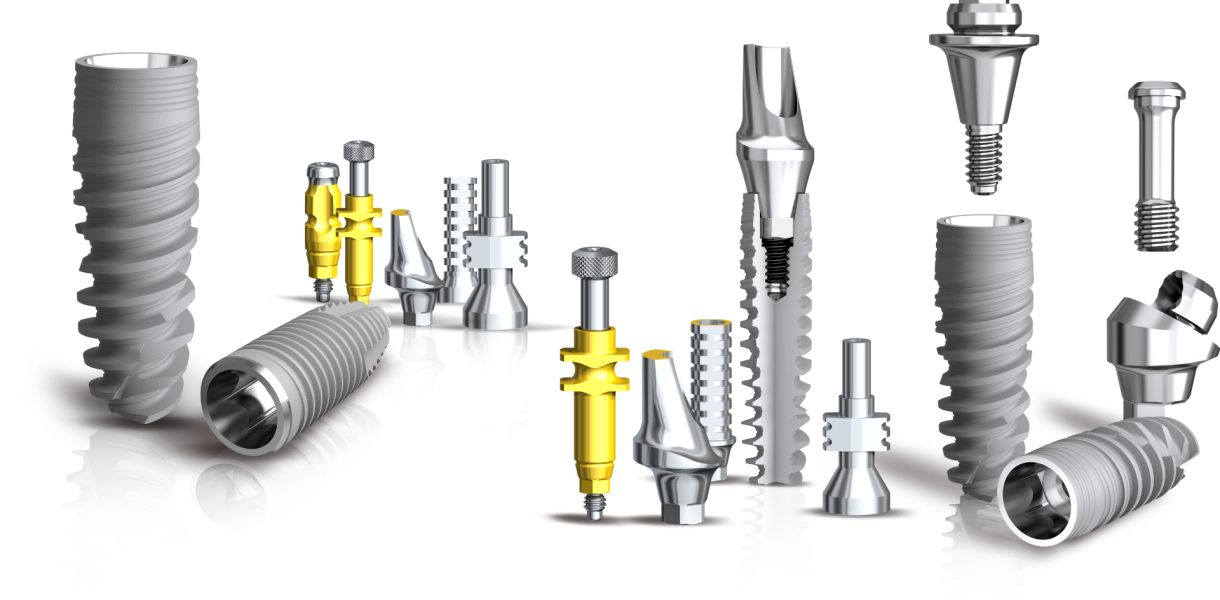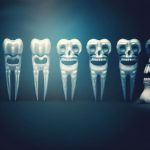According to statistics, more than 50% of adults in China suffer from tooth loss, and the incidence increases significantly with age. Missing teeth not only directly affect chewing efficiency—preventing food from being properly ground and increasing the burden on the digestive system, potentially leading to gastrointestinal diseases over time—but also disrupt facial contours, causing lip collapse, increased wrinkles, and reduced aesthetics and self-confidence. In addition, tooth loss may result in the tilting of adjacent teeth and overeruption of opposing teeth, which can lead to occlusal disorders and even temporomandibular joint disorder (TMD).
Traditional restorative methods such as removable dentures often feel unstable and foreign in the mouth, while fixed bridges require the grinding of healthy neighboring teeth. In contrast, dental implants offer a superior solution for patients with missing teeth.
Dental implant technology originated in the 1950s when Swedish professor Per-Ingvar Brånemark discovered the biocompatibility between titanium and bone tissue, laying the foundation for modern implant dentistry. The core advantages of dental implants include:
- High stability: Through osseointegration, the implant forms a tight bond with the jawbone, providing support comparable to natural tooth roots and avoiding issues like looseness and detachment seen with traditional dentures;
- Preservation of adjacent teeth: There is no need to grind down healthy teeth, allowing for maximum retention of natural dentition;
- Functional and aesthetic benefits: All-ceramic or porcelain-fused crowns closely resemble natural teeth in shape and color, with chewing efficiency reaching over 90% of that of natural teeth;
- Long lifespan: Clinical studies show that with proper maintenance, the 10-year survival rate of dental implants exceeds 95%, significantly outperforming traditional restorative methods.
However, the implantation process involves multiple stages of precise procedures and healing periods. Patients must have a clear understanding of how dental implants work and the associated timeline in order to achieve optimal results.
What are dental implants?
This article aims to provide a comprehensive overview of how dental implants function—starting with the context of tooth loss and explaining the basic concept of implants. It then outlines each phase in detail: preoperative assessment, implant placement, osseointegration period, healing abutment installation, impression-taking and crown fabrication, and final crown placement. Postoperative care guidelines are also covered, enabling readers to fully understand the entire journey from beginning to long-term use of dental implants.
Dental implants are a high-tech medical technique used to restore missing teeth. The core principle involves using pure titanium or titanium alloy materials—highly compatible with human bone tissue—to create implant fixtures that resemble natural tooth roots in cylindrical, conical, or other anatomical shapes through precision engineering. Through minimally invasive surgical procedures, these implants are accurately placed into the alveolar bone of the edentulous area to replace the root structure of the missing tooth.
After surgery, a 1–3 month osseointegration period is required, during which the implant biologically bonds with the jawbone. Once this stable integration is achieved, a crown—made of porcelain-fused-to-metal (PFM), all-ceramic, or metal-ceramic materials—is installed above the implant to complete both the functional and aesthetic restoration of the tooth. This process does not rely on adjacent teeth for support, thereby closely mimicking the natural physiological structure of real teeth.
Components of a Dental Implant
- Implant Fixture (Artificial Root)
As the foundation of the entire restoration system, the implant fixture is typically made of pure titanium or titanium alloy, offering excellent biocompatibility and corrosion resistance. Its surface is specially treated (e.g., sandblasted and acid-etched) to accelerate bone cell adhesion and promote osseointegration. Depending on the condition of the edentulous area, implant shapes may include cylindrical, conical, or threaded designs to suit different bone densities and anatomical structures. - Abutment (Connecting Component)
The abutment is a key component that connects the implant fixture to the crown. There are two types: healing abutments and restorative abutments. Healing abutments guide gum tissue formation during the osseointegration phase, while restorative abutments transfer chewing forces and hold the crown in place. Materials commonly used include titanium alloy for high strength and zirconia for better aesthetics—especially suitable for anterior restorations. - Crown (Visible Portion)
The crown restores the appearance and function of the tooth. Materials include all-ceramic, porcelain-fused-to-metal (PFM), and metal-ceramic. All-ceramic crowns offer excellent translucency and a natural appearance, ideal for aesthetic front-tooth restorations. PFM crowns have a metal base covered with a ceramic layer, balancing strength and aesthetics. Metal-ceramic crowns are known for their durability and cost-effectiveness. Crowns are connected to the abutment via screw-retained or cement-retained methods, ensuring long-term stability.
Dental Implant Procedure Workflow
1. Preoperative Assessment and Preparation
- Oral Examination: Includes panoramic X-rays, CT scans, and other diagnostics to thoroughly evaluate the alveolar bone density, height, width of the edentulous area, and surrounding structures such as adjacent teeth and periodontal tissues. This helps determine the suitability for dental implantation.
- General Health Evaluation: Collects the patient’s medical history, including chronic conditions like hypertension, diabetes, and heart disease, as well as any medications that may affect the surgical procedure. This ensures the patient is physically fit to undergo implant surgery.
- Treatment Planning: Based on the oral and general evaluations, the dentist and patient jointly develop a personalized implant plan. This includes determining the type, number, and position of implants, and whether bone grafting procedures are required.
2. Implant Placement Surgery
- Ideal vs. Real-World Scenarios: Ideally, an implant is placed immediately after extracting a non-restorable tooth. However, in practice, most cases require a healing period of 3–6 months post-extraction for the alveolar bone to regenerate before implant placement.
- Surgical Procedure:
- Local Anesthesia: Ensures the patient feels no pain during the procedure.
- Gingival Incision: A small incision is made in the gum tissue to expose the alveolar bone.
- Osteotomy (Drilling): A specialized tool is used to create a socket in the bone that matches the implant’s size and shape.
- Implant Insertion: The implant is carefully placed into the prepared site, ensuring accurate positioning and primary stability.
- Suturing: The gums are sutured to cover the implant and promote healing.
- Postoperative Care: Patients are advised on possible symptoms such as mild pain, swelling, or bleeding, and how to manage them using anti-inflammatory and pain-relief medications. Vigorous exercise and hard foods should be avoided.
3. Osseointegration Period
- Definition: Osseointegration refers to the direct structural and functional connection between the implant surface and bone, which is essential for the long-term success of the implant.
- Duration: Typically takes 3 to 6 months, depending on factors such as the patient’s age, health condition, and bone quality.
- Care Tips: During this phase, patients should maintain excellent oral hygiene, avoid any impact on the implant area, and attend regular follow-ups so the dentist can monitor osseointegration progress.
4. Healing Abutment Placement
- Purpose: The healing abutment is a temporary component that guides gum tissue shaping to create an ideal emergence profile for the final crown.
- Procedure: After successful osseointegration, a minor second surgery is performed. The gum is reopened, the cover screw is removed, and the healing abutment is installed, which remains exposed in the oral cavity.
- Postoperative Care: Emphasize oral hygiene to prevent food debris from accumulating around the healing abutment and causing infection.
5. Impression Taking and Crown Fabrication
- Impression: Once the soft tissue around the implant has healed and stabilized (typically 2–3 weeks after healing abutment placement), a precise dental impression is taken, including occlusal relationships.
- Crown Fabrication: The impression is sent to a dental lab, where a customized crown is fabricated according to the dentist’s specifications. Crown materials include porcelain-fused-to-metal (PFM), all-ceramic, and others, each with specific indications.
6. Final Crown Placement
- Installation Procedure: During the final appointment, the healing abutment is removed, a permanent abutment is installed, and the finished crown is tried in. The dentist adjusts the occlusion, shape, and color to ensure it blends seamlessly with adjacent teeth and restores full chewing function. The crown is then permanently affixed using cement or screw-retained methods.
- Post-placement Check: The dentist verifies the fit, occlusion, and stability of the crown and makes any necessary adjustments to ensure patient comfort and long-term performance.
Postoperative Care and Long-Term Maintenance of Dental Implants
1. Daily Oral Hygiene
Patients with dental implants should maintain oral hygiene as diligently as they would for natural teeth. Proper brushing techniques, such as the Bass method, should be used at least twice daily for no less than three minutes each time. Additionally, interdental brushes, dental floss, and water flossers are recommended to clean the spaces between implants and adjacent teeth, helping to prevent food debris buildup and plaque formation.
2. Regular Follow-Up Appointments
Patients should attend follow-up appointments as instructed by their dentist. Typically, during the first year after surgery, reviews are scheduled every three months. In the following years, annual check-ups one to two times a year are advised. During these visits, the dentist will evaluate the condition of the implant, surrounding tissues, crown stability, and occlusion, and will address any potential issues early.
3. Dietary Adjustments
After implant restoration, patients are advised to avoid extremely hard or sticky foods such as nuts, bones, and chewing gum, to prevent damage to the crown or implant instability. Smoking and excessive alcohol consumption should also be avoided, as they can impair blood circulation in the oral tissues and increase the risk of peri-implantitis.
What are the advantages of dental implants?
Compared with traditional dentures (such as removable dentures and fixed bridges), dental implants offer significant advantages as an ideal restoration method in modern dentistry. These advantages are mainly reflected in the following aspects:
1. Functionality and Stability: Chewing Like Natural Teeth
- Firm Support: Dental implants form a biomechanical support similar to natural tooth roots through osseointegration between the implant and the jawbone. This allows chewing force to be directly transmitted to the jawbone, avoiding the weak bite or dislodgement often caused by loose denture bases.
- Clinical Data: The biting force of dental implants can reach 80%–90% of that of natural teeth, while removable dentures typically restore only about 30%.
- Protects Adjacent Teeth: Traditional fixed bridges require the grinding down of adjacent healthy teeth as abutments, which may lead to pulp sensitivity, tooth decay, or fractures. In contrast, implants are placed independently without relying on neighboring teeth, thereby preserving the integrity of the dental arch.
2. Aesthetics and Comfort: As Natural as Real Teeth
- Lifelike Appearance
The crown is made of all-ceramic or porcelain-fused-to-metal materials, closely matching the color and shape of natural teeth. This is especially beneficial for anterior restorations and solves the aesthetic problems caused by visible metal clasps in removable dentures. - Comfort Without Foreign Body Sensation
Dental implants do not use bases or clasps, avoiding pressure on the oral mucosa. Long-term use does not cause pain or ulcers, making adaptation easier for patients.
3. Long-Term Health Benefits: Prevent Bone Loss and Tooth Movement
- Maintains Alveolar Bone Height
After tooth loss, the alveolar bone gradually resorbs due to lack of physiological stimulation, leading to facial collapse. Dental implants transfer chewing forces through artificial roots, stimulating bone regeneration and effectively preventing bone resorption. - Prevents Tooth Drift
After conventional denture placement, adjacent teeth may tilt into the gap, and opposing teeth may over-erupt, causing occlusal disorders. Dental implants fill the space and maintain the stability of the dental arch.
4. Service Life and Cost-Effectiveness: Lower Long-Term Cost
- High Durability
With proper care, the 10-year survival rate of dental implants exceeds 95%, and the 20-year rate remains above 85%, significantly outperforming removable dentures (which usually need replacing every 5–10 years) and fixed bridges (which typically last 10–15 years). - Long-Term Cost Advantage
Although the initial cost is higher, implants avoid frequent replacements and protect adjacent teeth from damage. In the long run, the total maintenance cost may be lower than that of traditional dentures.
5. Broad Indications: Solving Complex Tooth Loss
- Single or Multiple Tooth Loss Restoration
Customized plans can be made for single or multiple missing teeth, avoiding the large base required by traditional dentures. - Full-Arch Edentulous Restoration
Techniques like All-on-4 or All-on-6 allow the restoration of a full arch with just 4–6 implants, addressing the poor retention issues of conventional full dentures. - Immediate Implant Placement
In some cases, implants can be placed immediately after tooth extraction, shortening the treatment time and reducing the trauma of a second surgery.
6. Psychological and Social Benefits: Improved Quality of Life
- Boosts Confidence
Aesthetic and natural restoration helps patients regain their smile and reduce social anxiety caused by tooth loss. - Clear Speech
Traditional dentures with large bases may affect pronunciation. Dental implants avoid this problem, ensuring normal speech function.
Comparison with Traditional Restoration Methods
| Comparison Dimension | Dental Implants | Removable Dentures | Fixed Bridges |
|---|---|---|---|
| Stability | Osseointegrated, firm and durable | Easily loosened, needs regular adjustment | Relies on adjacent teeth, may loosen |
| Aesthetics | All-ceramic/porcelain crowns, natural look | Visible metal clasps affect appearance | Requires grinding teeth, may appear fake |
| Impact on Adjacent Teeth | Independent support, no damage | No damage, but may compress gums over time | Requires grinding healthy adjacent teeth |
| Service Life | 20+ years | 5–10 years | 10–15 years |
| Comfort | No foreign body sensation, adapts easily | Base pressure causes strong discomfort | May be sensitive initially |
| Cost | Higher initial cost, better long-term value | Lower initial cost, frequent replacement | Moderate cost, requires adjacent tooth work |
Conclusion
Reviewing the entire workflow of dental implants—from preoperative assessment, implant placement, osseointegration, installation of the healing abutment, impression-taking and crown fabrication, to the final crown placement—each step is crucial and interconnected. Dental implants offer significant advantages in the restoration of missing teeth. The success of an implant depends not only on surgical techniques but also on the patient’s diligent postoperative care and long-term maintenance. Patients should actively cooperate with their dentist’s treatment and care recommendations to achieve long-lasting and stable results with their dental implants.






